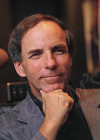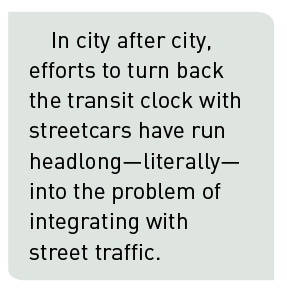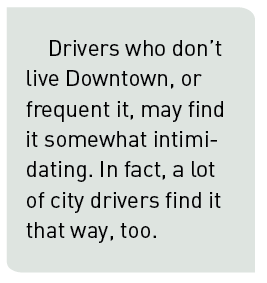HOME | ABOUT US | MEDIA KIT | CONTACT US | INQUIRE
HOME | ABOUT US | MEDIA KIT | CONTACT US | INQUIRE

A video posted on The Kansas City Star Web site reminds us why Kansas City tore up and paved over more than 300 miles of streetcar lines some 60 years ago—and why we should have left them buried.
A streetcar on a test run is heading south towards the heart of Downtown when it approaches a car parked illegally, too close to the tracks. With parking having long been a challenge Downtown, one gets the sense that driver was making a quick pit stop at the Country Club Bank on the west side of the street and had no place else to park.
 Whatever the driver’s motives, the streetcar conductor is forced to stop. Unlike a bus driver, he cannot simply drive around the scofflaw’s car. When he stops, all the cars behind him are forced to stop. Fortunately, there are at least two conductors on this streetcar, so one of the two leaves the streetcar and goes to hunt down the offender.
Whatever the driver’s motives, the streetcar conductor is forced to stop. Unlike a bus driver, he cannot simply drive around the scofflaw’s car. When he stops, all the cars behind him are forced to stop. Fortunately, there are at least two conductors on this streetcar, so one of the two leaves the streetcar and goes to hunt down the offender.
Frustrated, a driver behind the streetcar circles around it and passes. While the man is passing, the conductor in the streetcar lets loose a couple of horn blasts fully intended to scold. The driver gets the message.
Miffed, he stops in front of the streetcar, gets out of the car, and yells something at the conductor. Although there is no sound—and that’s a shame—he seems to be saying something like, “Whiskey Tango Foxtrot?” I imagine he was thinking, “What did you expect me to do? Sit here until someone moved the car?”
By this time, the scofflaw has made his humbling perp walk back to the car and drives away. The miffed driver, meanwhile, is back in his car and proceeds to the intersection. But when the streetcar begins moving slowly forward, the miffed driver stops in front of him, puts on his emergency flashers, and exits the car.
From the looks of things, this beef has not been settled. The driver heads back to the streetcar, and there, alas, we lose both sight of him and sound—just, I suspect, when things were about to get really interesting.
“The biggest roadblock to Kansas City’s streetcar success,” The Star now tells us, “may be exactly that—cars blocking the road and the streetcar’s rail path.” Oh, yeah! Why didn’t someone say this before we sunk more than $100 million into a congested two-mile track that takes no one anyplace useful and solves no known problem?
The car thing was no secret. Dan Bower, streetcar imam from the millennial Mecca of Portland, tells The Star that when he talks to transport people from other cities, the question of how to integrate streetcars into mixed traffic “has come up more than anything else.”
And Kansas City is no Portland. That city is filled with young “creatives” whose parental subsidies may cover food, housing, and tattoos, but rarely automobiles. Kansas City has been proudly auto-centric since J.C. Nichols defied the Pendergast machine and built his city on the hills—Mission, Armour etc.—beyond the reach of the thugocracy’s extortionate streetcar lines.
On the first day of March, the inheritors of these two worlds collided, literally. The newspaper headline speaks to the unspoken class undercurrent in the debate, “Kansas City streetcar hits parked Mercedes.” Something tells me that if it were my car involved in the accident, the headline would not have read, “Kansas City streetcar hits parked Ford Escape.”
As the story goes, a southbound Kansas City streetcar hit a Mercedes that was not parked fully within the designated white lines on Main Street. “Streetcar operators are supposed to be learning how close they can come to those vehicles that are parked outside the white line without hitting them,” writes Yael Abouhalkah, one of The Star’s peppy streetcar cheerleaders. Yeah, that would be nice.
The story’s real punch line, however, is that the Mercedes had Johnson County plates. This was a source of much Twitter humor among the streetcar-happy Millennials who may not know who fought in the Civil War, but do know enough to find Johnson County humorous.
Unfortunately, the joke is on the city. In fact, many Johnson Countians don’t know how to parallel park. Drivers can spend their entire lives in that county without ever negotiating anything trickier than a diagonal parking spot in Nordstrom’s spacious outdoor lot. I am told Kansas does not even test for parallel parking.
 Downtown intimidates them. Hell, Downtown intimidates me, and I cut my driving teeth on the Garden State Parkway. If the streetcar makes people like me and the Mercedes drivers of Johnson County less likely to go Downtown, it has fully undermined
Downtown intimidates them. Hell, Downtown intimidates me, and I cut my driving teeth on the Garden State Parkway. If the streetcar makes people like me and the Mercedes drivers of Johnson County less likely to go Downtown, it has fully undermined
its very reason for existence.
“We will get through this,” Abouhalkah assured his readers. “The incident Tuesday should not be used to denigrate the potential of the streetcar line to continue with Downtown’s economic redevelopment.”
“Denigrate” is the wrong word here. It means “criticize unfairly.” A more useful word might be “educate.” I would rephrase the money quote thusly: The incident Tuesday should be used to educate citizens on the folly of spending $102 million before learning of a problem “that has come up more than anything else,” everywhere else.”
Even in Portlandia.